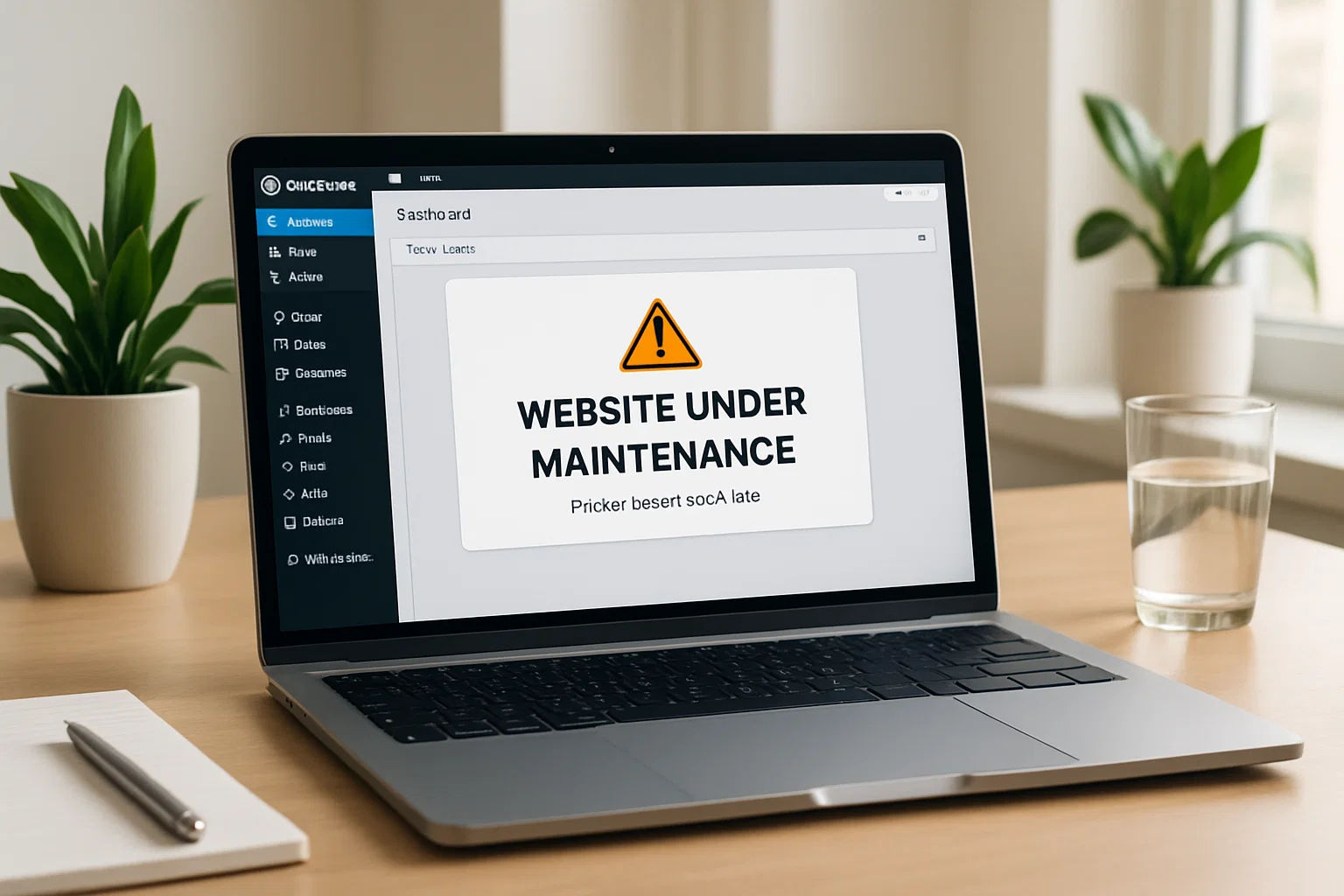
Then you panic, refresh again… and still the same thing. Worse, sometimes you see “Maintenance Mode -1” or a half-loaded page that looks like your blog just exploded.
Relax. It happens to almost everyone using WordPress long enough. The good news? It’s easy to fix once you know what’s happening behind the scenes.
Let’s break down what this annoying “Maintenance Mode -1” issue actually means, why it shows up, and most importantly how to get your site back online safely.
What Is WordPress Maintenance Mode -1?
When you update plugins, themes, or even WordPress itself, the system automatically goes into maintenance mode.
This feature is supposed to protect your site visitors from seeing weird half-updated code during installation.
Basically, WordPress creates a hidden file called .maintenance in your site’s root directory (where wp-config.php lives). That file temporarily tells everyone,
“Hold up, we’re doing updates check back soon.”
Normally, it’s deleted automatically when updates finish.
But sometimes things go wrong a slow server, a big plugin update, or an interruption mid-process. When that happens, the .maintenance file doesn’t get deleted… and voilà: your site gets stuck showing the maintenance message forever.
The “-1” part isn’t official it usually shows when something in the process glitched or repeated itself. So “Maintenance Mode -1” just means WordPress tried again and failed to clear the mode properly.
Why Does the Maintenance Mode Error Happen?
A few common reasons trigger this WordPress hiccup:
- Interrupted Updates You refreshed or closed the browser mid-update.
- Timeouts or Server Lag Cheap shared hosting, heavy plugins, or low memory limit.
- Plugin Conflicts Two updates clash or one plugin tries to update itself while another is running.
- Failed Auto-Updates WordPress sometimes auto-updates in the background; if it times out, maintenance mode stays stuck.
- Permissions or File Errors The
.maintenancefile can’t delete itself due to wrong file permissions.
So yeah it’s not really your fault. But you’ll need to clean it up manually.
How to Get Out of WordPress Maintenance Mode -1
Let’s fix this step by step no coding degree required.
Step 1: Access Your Site Files
You can do this two ways:
a. Using cPanel → File Manager
Most hosts give you cPanel. Log in, open File Manager, and navigate to the folder named public_html (or whatever your site’s root is).
b. Using an FTP client like FileZilla
Connect to your site using FTP credentials. (Ask your hosting support if you don’t know them.)
You’re looking for your root directory the one containing folders like wp-content, wp-admin, wp-includes.
Step 2: Find and Delete the .maintenance File
Inside that root folder, you’ll see a small file named .maintenance.
Delete it.
Yep, that’s it.
Now reload your website. If all went well, you’ll be back online instantly.
If you don’t see the file, ensure “Show Hidden Files” is enabled in File Manager settings it might be invisible by default.
Step 3: Clear Your Cache
Even after deleting the file, your browser or caching plugin might still show the maintenance page.
- Clear browser cache (Ctrl + Shift + R).
- Clear plugin caches (like WP Rocket, LiteSpeed Cache, or W3 Total Cache).
- If you use Cloudflare, purge its cache too.
Refresh your site again. The maintenance message should vanish.
Step 4: Double-Check for Incomplete Updates
Go to your WordPress Dashboard → Plugins → Installed Plugins.
Look for any plugin still marked “Updating” or “Needs update.”
Re-run updates one by one. Same goes for themes or the WordPress core if it stopped mid-process.
This ensures everything finished properly so the issue doesn’t reappear.
How to Turn Maintenance Mode On (the Right Way)
Sometimes, you want your site in maintenance mode like when you’re redesigning, fixing bugs, or launching something new. But the safe way is not the default “automatic update” one.
Option 1: Use a Plugin
If you’re not into coding, grab one of these free gems:
| Plugin | Key Feature | Ease of Use |
|---|---|---|
| WP Maintenance Mode & Coming Soon | Add custom message, countdown timer, subscriber form. | ⭐⭐⭐⭐ |
| SeedProd Coming Soon Page | Drag-and-drop builder, beautiful templates. | ⭐⭐⭐⭐⭐ |
| Maintenance by WebFactory Ltd | Lightweight and clean for quick maintenance toggles. | ⭐⭐⭐⭐ |
Activate your plugin, design your maintenance page, and you’re set.
These tools let you keep search engines happy (no ranking loss) and even whitelist your IP so you can still browse the site privately.
Option 2: Enable Maintenance Manually
For devs or minimalists, you can drop this simple PHP snippet in your theme’s functions.php:
When ready to reopen your site, remove the snippet.
It’s a clean method that never leaves a .maintenance file behind.
Why Are People Moving Away from WordPress (and Should You)?
This question often pops up when beginners hit issues like maintenance mode, plugin errors, or slow dashboards.
Truth is, people aren’t running from WordPress they’re running from bad setups.
WordPress still powers over 40% of all websites in 2025. It’s not dying; it’s just evolving.
But some users switch to simpler platforms like Wix, Notion Sites, or Ghost because they:
- Don’t want to manage hosting or updates.
- Got overwhelmed by technical fixes (like this one).
- Prefer drag-and-drop simplicity with less responsibility.
If you want to stay with WordPress (and you should, if you love flexibility), just remember:
A little site care and smart setup keep it running smoother than any closed-source alternative.
Smart Habits to Prevent Maintenance Mode Issues
You’ve fixed it once let’s make sure it never happens again.
Here are some pro tips straight from years of WordPress firefighting.
1. Update One Thing at a Time
Updating all plugins in bulk looks convenient but often breaks something mid-update.
Do it in batches plugin by plugin, theme after theme.
2. Use a Staging Site
Every decent host now offers a staging environment. Test updates there first.
If all goes well, push them live with one click.
3. Back Up Before You Touch Anything
Install a free tool like UpdraftPlus or WP Vivid Backup.
You’ll thank yourself when something goes wrong.
4. Choose Quality Hosting
Those $2/month shared plans? They choke during updates.
Look for hosts optimised for WordPress with good uptime and PHP memory (512 MB +).
5. Watch File Permissions
WordPress usually needs 755 for folders and 644 for files.
Wrong permissions can stop the .maintenance file from deleting itself.
6. Disable Auto-Updates if Your Host Is Slow
Auto-updates at 3 a.m. sound nice until a slow host times out.
Switch them off and do updates manually once a week.
7. Optimise Database Regularly
Use a plugin like WP-Optimize to clear leftover update logs and revisions.
Lighter database = fewer failed updates.
Troubleshooting Deep-Level Problems
Sometimes deleting .maintenance doesn’t fix it. That’s when you roll up your sleeves.
Check for a Broken .htaccess File
If your homepage still won’t load, your .htaccess might have been corrupted.
Rename it to .htaccess_old, then log in to your dashboard → Settings → Permalinks → Save Changes.
WordPress will regenerate a clean file.
Re-Upload Core Files
Grab a fresh WordPress zip from wordpress.org, unzip it, and re-upload only wp-admin and wp-includes folders via FTP.
Don’t touch wp-content (that’s where your stuff lives).
Check PHP Version
Some old themes or plugins break on newer PHP versions (8.2+).
Ask your host which PHP version your server runs you can switch it in cPanel → Select PHP Version.
Bonus: Create a Custom Maintenance Page That Builds Trust
Most users panic when they see a bland “Briefly unavailable” screen.
Why not turn that downtime into a professional-looking pause page?
Even a short custom message like this builds credibility:
“Hey there! We’re upgrading our site to serve you better.
We’ll be back online shortly. Thanks for your patience!”
Add your logo, social links, and maybe a progress bar and you’ll look like you planned the whole thing.
If you use a plugin like SeedProd, you can even collect emails during maintenance.
Smart move, right?
When to Call Your Host for Help
Sometimes the problem isn’t your fault. Call your hosting support if:
- You deleted
.maintenancebut the message won’t disappear. - FTP shows weird permission errors.
- You’re locked out of the dashboard entirely.
- Updates keep timing out despite a clean setup.
Good hosts can fix this in minutes by adjusting file permissions or server settings.
The Reality of WordPress Maintenance in 2025
WordPress is more powerful than ever but it’s also heavier.
Plugins like Elementor, WooCommerce, and AI writing tools eat up memory like snacks.
The key is balance:
Keep your site light, plugins updated, and hosting strong.
Do that, and you’ll rarely face maintenance issues again.
And honestly, once you’ve fixed this once, you’ll laugh next time it happens because you’ll know exactly what to do.
Quick Recap
| Problem | Cause | Solution |
|---|---|---|
| Stuck in “Briefly unavailable” message | .maintenance file left behind | Delete the file via File Manager |
| Updates failed midway | Timeout or low memory | Update one item at a time |
| Cache still shows old page | Browser or plugin cache | Clear cache everywhere |
| Maintenance Mode -1 reappears | Auto-update glitch | Disable auto-updates, update manually |
| Blank screen after fix | Corrupt .htaccess | Regenerate via Permalink settings |
WordPress Pro Tip
Before major plugin updates, take 3 minutes to activate a “Coming Soon” plugin and back up your site.
That habit alone can save you hours of stress later.
Final Thoughts
Getting stuck in WordPress Maintenance Mode -1 can feel terrifying like your whole business just vanished.
But now you know it’s just a forgotten .maintenance file waiting to be deleted.
With the quick-fix steps above, a little caution, and a decent host, you’ll keep your WordPress site healthy and resilient.
Remember: WordPress doesn’t need to be scary. It just needs a bit of regular care.

Alex WebPro, your guide to web mastery. Expert tips on WordPress, SEO, monetization, and the best in design trends and themes.